REY Spatial Distribution and Mineral Association in Coal, Carbonaceous Shale and Siltstone: Implications for REE Enrichment Mechanisms
Abstract
1. Introduction
2. Materials and Methods
2.1. Geological Setting
2.2. Sample Selection
2.3. Petrography and SEM–EDS
3. Results
3.1. ICP-MS Geochemical Sample Characterization
3.2. Petrography and SEM–EDS Grain Characteristics
3.3. Silt-Size REY-Enriched Grains
3.4. Clay-Size REY-Enriched Grains
3.5. Organically Associated REYs
3.6. LREE-to-HREE Ratios and Non-REY CMs
4. Discussion
5. Conclusions
Author Contributions
Funding
Data Availability Statement
Conflicts of Interest
References
- Leslie, H.F.; Nordvig, M.; Brink, S. Critical Materials Strategy 2010; U.S. Department of the Interior: Washington, DC, USA, 2010; pp. 1–166.
- Henderson, P.; Gluyas, J.; Gunn, G.; Wall, F.; Woolley, A.; Finlay, A.; Bilham, N. Rare Earth Elements: A Briefing Note by the Geological Society of London; Geological Society of London: London, UK, 2011. [Google Scholar]
- Humphries, M. Rare Earth Elements: The Global Supply Chain. In Rare Earth Minerals Policies Issues; Elsevier: Amsterdam, The Netherlands, 2011; pp. 1–20. [Google Scholar]
- Alonso, E.; Sherman, A.M.; Wallington, T.J.; Everson, M.P.; Field, F.R.; Roth, R. Evaluating Rare Earth Element Availability: A Case with Revolutionary Demand from Clean Technologies. Environ. Sci. Technol. 2012, 46, 3406–3414. [Google Scholar] [CrossRef] [PubMed]
- Long, K.R.; Van Gosen, B.S.; Foley, N.K.; Cordier, D. The Principal Rare Earth Elements Deposits of the United States: A Summary of Domestic Deposits and a Global Perspective. In Non-Renewable Resources: Issues, Geoscientific Society Challenges; Springer: Berlin/Heidelberg, Germany, 2012; pp. 131–155. [Google Scholar] [CrossRef]
- Weng, Z.H.; Jowitt, S.M.; Mudd, G.M.; Haque, N. Assessing Rare Earth Element Mineral Deposit Types and Links to Environmental Impacts. Trans. Inst. Min. Metall. B Appl. Earth Sci. 2014, 122, 83–96. [Google Scholar] [CrossRef]
- Hower, J.C.; Granite, E.J.; Mayfield, D.B.; Lewis, A.S.; Finkelman, R.B. Notes on Contributions to the Science of Rare Earth Element Enrichment in Coal and Coal Combustion Byproducts. Minerals 2016, 6, 32. [Google Scholar] [CrossRef]
- Zhou, B.; Li, Z.; Zhao, Y.; Zhang, C.; Wei, Y. Rare Earth Elements Supply vs. Clean Energy Technologies: New Problems to Be Solved. Gospod. Surowc. Miner./Miner. Resour. Manag. 2016, 32, 29–44. [Google Scholar] [CrossRef]
- Hower, J.C.; Warwick, P.; Scanlon, B.R.; Reedy, R.C.; Childress, T.M. Distribution of Rare Earth and Other Critical Elements in Lignites from the Eocene Jackson Group, Texas. Int. J. Coal Geol. 2023, 275, 104302. [Google Scholar] [CrossRef]
- Coe, H.H.; Birgenheier, L.P.; Fernandez, D.P.; Gall, R.D.; Vanden Berg, M.D.; Giebel, A. Rare Earth Element Enrichment in Coal and Coal-Adjacent Strata of the Uinta Region, Utah and Colorado. Front. Earth Sci. 2024, 12, 1381152. [Google Scholar] [CrossRef]
- Birgenheier, L.P.; Coe, H.; Morris, E.; Gall, R.; Fausett, P.; Wilcock, L.; Bailey, N.; Vanden Berg, M.D.; Giebel, A.; Fernandez, D. Basinal Assessment of Carbon Ore, Rare Earth, and Critical Minerals (CORE-CM) Resources. In CORE-CM: Transforming Uinta Basin Earth Materials into Advanced Products, Final Report to DOE; Free, M., Ed.; DOE Project: DE-FE0032046, No. DOE UU 32046; U.S. Department of Energy, DOE: Washington, DC, USA, 2024; pp. 21–168. [Google Scholar] [CrossRef]
- U.S. Geological Survey. Mineral Commodity Summaries 2024; U.S. Geological Survey: Reston, VA, USA, 2024; p. 212. [CrossRef]
- Golev, A.; Scott, M.; Erskine, P.D.; Ali, S.H.; Ballantyne, G.R. Rare Earths Supply Chains: Current Status, Constraints and Opportunities. Resour. Policy 2014, 41, 52–59. [Google Scholar] [CrossRef]
- Laudal, D.A.; Benson, S.A.; Palo, D.; Addleman, R.S. Rare Earth Elements in North Dakota Lignite Coal and Lignite-Related Materials. J. Energy Resour. Technol. 2018, 140, 062205. [Google Scholar] [CrossRef]
- Gupta, C.K.; Krishnamurthy, N. Extractive Metallurgy of Rare Earths; CRC Press: Boca Raton, FL, USA, 2005. [Google Scholar]
- Zhou, B.; Li, Z.; Chen, C. Global Potential of Rare Earth Resources and Rare-Earth Demand from Clean Technologies. Minerals 2017, 7, 203. [Google Scholar] [CrossRef]
- Seredin, V.V.; Dai, S. Coal Deposits as Potential Alternative Sources for Lanthanides and Yttrium. Int. J. Coal Geol. 2012, 94, 67–93. [Google Scholar] [CrossRef]
- Lin, R.; Soong, Y.; Granite, E.J. Evaluation of Trace Elements in U.S. Coals Using the USGS COALQUAL Database Version 3.0. Part I: Rare Earth Elements and Yttrium (REY). Int. J. Coal Geol. 2018, 192, 1–13. [Google Scholar] [CrossRef]
- Zhang, W.; Noble, A.; Yang, X.; Honaker, R. A Comprehensive Review of Rare Earth Elements Recovery from Coal-Related Materials. Minerals 2020, 10, 451. [Google Scholar] [CrossRef]
- Finkelman, R.B.; Palmer, C.A.; Wang, P. Quantification of the Modes of Occurrence of 42 Elements in Coal. Int. J. Coal Geol. 2018, 185, 138–160. [Google Scholar] [CrossRef]
- Finkelman, R.B.; Dai, S.; French, D. The importance of minerals in coal as the hosts of chemical elements: A review. Int. J. Coal Geol. 2019, 212, 103251. [Google Scholar] [CrossRef]
- Dai, S.; Finkelman, R.B. Coal as a promising source of critical elements: Progress and future prospects. Int. J. Coal Geol. 2018, 186, 155–164. [Google Scholar] [CrossRef]
- Fu, B.; Xu, G.; Hower, J.C.; Cao, Y.; Huang, Y.; Si, L.; Xian, L.; Luo, G.; Liu, G.; Hu, G.; et al. Recognition and Semi-Quantitative Analysis of REY-Bearing Minerals in Coal Using Automated Scanning Electron Microscopy. Int. J. Coal Geol. 2024, 282, 104443. [Google Scholar] [CrossRef]
- Yesenchak, R.; Sharma, S.; Lopano, C.; Montross, S. Rare-Earth Element Phase Associations in Four West Virginia Coal Samples. Minerals 2024, 14, 362. [Google Scholar] [CrossRef]
- Thomas, B.S.; Dimitriadis, P.; Kundu, C.; Vuppaladadiyam, S.S.V.; Raman, R.K.S.; Bhattacharya, S. Extraction and Separation of Rare Earth Elements from Coal and Coal Fly Ash: A Review on Fundamental Understanding and Ongoing Engineering Advancements. J. Environ. Chem. Eng. 2024, 12, 112769. [Google Scholar] [CrossRef]
- Balaram, V. Potential Future Alternative Resources for Rare Earth Elements: Opportunities and Challenges. Minerals 2023, 13, 425. [Google Scholar] [CrossRef]
- Yang, J.; Montross, S.; Britton, J.; Stuckman, M.; Lopano, C.; Verba, C. Microanalytical Approaches to Characterizing REY in Appalachian Basin Underclays. Minerals 2020, 10, 546. [Google Scholar] [CrossRef]
- Lin, R.; Howard, B.H.; Roth, E.A.; Bank, T.L.; Granite, E.J.; Soong, Y. Enrichment of Rare Earth Elements from Coal and Coal By-Products by Physical Separations. Fuel 2017, 200, 506–520. [Google Scholar] [CrossRef]
- Hower, J.C.; Groppo, J.G.; Hsu-Kim, H.; Taggart, R.K. Distribution of Rare Earth Elements in Fly Ash Derived from the Combustion of Illinois Basin Coals. Fuel 2021, 289, 119990. [Google Scholar] [CrossRef]
- Modiga, A.; Eterigho-Ikelegbe, O.; Bada, S. Extractability and Mineralogical Evaluation of Rare Earth Elements from Waterberg Coalfield Run-of-Mine and Discard Coal. Int. J. Coal Sci. Technol. 2024, 11, 65. [Google Scholar] [CrossRef]
- Hower, J.C.; Eble, C.F.; Dai, S.; Belkin, H.E. Distribution of Rare Earth Elements in Eastern Kentucky Coals: Indicators of Multiple Modes of Enrichment? Int. J. Coal Geol. 2016, 160–161, 73–81. [Google Scholar] [CrossRef]
- Hower, J.C.; Eble, C.F.; Backus, J.S.; Xie, P.; Liu, J.; Fu, B.; Hood, M.M. Aspects of Rare Earth Element Enrichment in Central Appalachian Coals. Appl. Geochem. 2020, 120, 104676. [Google Scholar] [CrossRef]
- Liu, J.; Dai, S.; Berti, D.; Eble, C.F.; Dong, M.; Gao, Y.; Hower, J.C. Rare Earth and Critical Element Chemistry of the Volcanic Ash-Fall Parting in the Fire Clay Coal, Eastern Kentucky, USA. Clays Clay Miner. 2023, 71, 309–339. [Google Scholar] [CrossRef]
- Crowley, S.S.; Stanton, R.W.; Ryer, T.A. The Effects of Volcanic Ash on the Maceral and Chemical Composition of the C Coal Bed, Emery Coalfield, Utah. Org. Geochem. 1989, 14, 315–331. [Google Scholar] [CrossRef]
- Mastalerz, M.; Drobniak, A.; Eble, C.; Ames, P.; McLaughlin, P. Rare Earth Elements and Yttrium in Pennsylvanian Coals and Shales in the Eastern Part of the Illinois Basin. Int. J. Coal Geol. 2020, 231, 103620. [Google Scholar] [CrossRef]
- Bau, M.; Schmidt, K.; Koschinsky, A.; Hein, J.; Kuhn, T.; Usui, A. Discriminating between Different Genetic Types of Marine Ferro-Manganese Crusts and Nodules Based on Rare Earth Elements and Yttrium. Chem. Geol. 2014, 381, 1–9. [Google Scholar] [CrossRef]
- Dai, S.; Graham, I.; Ward, C.R. A Review of Anomalous Rare Earth Elements and Yttrium in Coal. Int. J. Coal Geol. 2016, 159, 82–95. [Google Scholar] [CrossRef]
- Kaufman, E.G. Paleobiogeography and Evolutionary Response Dynamic in the Cretaceous Western Interior Seaway of North America. In Geological Association of Canada Special Paper 27; Geological Association of Canada (GAC): St. John’s, NL, Canada, 1984; pp. 1–34. [Google Scholar]
- Ardill, K.; Attia, S.; Memeti, V.; Paterson, S.R. Fingerprinting the Geochemical Signals of Episodic Arc Activity in the Sierra Nevada Batholith in Space and Time. Geol. Soc. Am. Bull. 2024, 136, 4321–4341. [Google Scholar] [CrossRef]
- Kauffman, E.G.; Caldwell, W.G.E. The Western Interior Basin in Space and Time. In Geological Association of Canada Special Paper 39; Geological Association of Canada (GAC): St. John’s, NL, Canada, 1993; pp. 1–30. [Google Scholar]
- Roberts, L.N.R.; Kirschbaum, M.A. Paleogeography and the Late Cretaceous of the Western Interior of Middle North America: Coal Distribution and Sediment Accumulation. In U.S. Geological Survey Professional Paper; U.S. Geological Survey: Reston, VA, USA, 1995. [Google Scholar] [CrossRef]
- Liu, S.; Nummedal, D.; Gurnis, M. Dynamic versus Flexural Controls of Late Cretaceous Western Interior Basin, USA. Earth Planet. Sci. Lett. 2014, 389, 221–229. [Google Scholar] [CrossRef]
- Yonkee, W.A.; Weil, A.B. Tectonic Evolution of the Sevier and Laramide Belts within the North American Cordillera Orogenic System. Earth Sci. Rev. 2015, 150, 531–593. [Google Scholar] [CrossRef]
- Gill, J.R.; Hail, W.J., Jr. Stratigraphic Sections Across Upper Cretaceous Mancos Shale-Mesaverde Group Boundary, Eastern Utah and Western Colorado; USGS Oil and Gas Investigation Chart; USGS National Center: Reston, VA, USA, 1975. [CrossRef]
- Spencer, C.W.; Wilson, R.J. Petroleum Geology and Principal Exploration Plays in the Uinta-Piceance-Eagle Basins Province, Utah and Colorado. In U.S. Geological Survey Open-File Report; USGS National Center: Reston, VA, USA, 1988; p. 35. [Google Scholar]
- Van Wagoner, J.C. Sequence Stratigraphy and Marine to Nonmarine Facies Architecture of Foreland Basin Strata, Book Cliffs, Utah, USA. In Sequence Stratigraphy of Foreland Basin Deposits; Van Wagoner, J.C., Bertram, G.T., Eds.; AAPG Memoir 64; American Association of Petroleum Geologists: Tulsa, OK, USA, 1995; pp. 137–223. [Google Scholar]
- Willis, A. Tectonic Control of Nested Sequence Architecture in the Sego Sandstone, Neslen Formation and Upper Castlegate Sandstone (Upper Cretaceous), Sevier Foreland Basin, Utah, USA. Sedimentology 2000, 136, 277–317. [Google Scholar] [CrossRef]
- Hettinger, R.D.; Kirschbaum, M.A. Stratigraphy of the Upper Cretaceous Mancos Shale (Upper Part) and Mesaverde Group in the Southern Part of the Uinta and Piceance Basins, Utah and Colorado; U.S. Geological Survey Digital Data Series; USGS National Center: Reston, VA, USA, 2003.
- Johnson, R.C.; Roberts, S.B. The Mesaverde Total Petroleum System, Uinta-Piceance Province, Utah and Colorado. In Petroleum Systems and Geologic Assessment of Oil and Gas in the Uinta-Piceance Province, Utah and Colorado; U.S. Geological Survey Digital Data Series; USGS National Center: Reston, VA, USA, 2003. [Google Scholar]
- Condon, S.M. Fracture Network of the Ferron Sandstone Member of the Mancos Shale, East-Central Utah, USA. Int. J. Coal Geol. 2003, 56, 111–139. [Google Scholar] [CrossRef]
- Ryer, T.A.; Anderson, P.B. Facies of the Ferron Sandstone, East-Central Utah. In Regional to Wellbore Analog for Fluvial-Deltaic Reservoir Modeling: The Ferron Sandstone of Utah; Chidsey, T.C., Jr., Adams, R.D., Morris, T.H., Eds.; American Association of Petroleum Geologists Studies in Geology: Tulsa, OK, USA, 2004; Volume 50, pp. 59–78. [Google Scholar]
- Chidsey, T.C., Jr.; Ryer, T.A.; Morris, T.H. Introduction—Geological and Petrophysical Characterization of the Ferron Sandstone for 3-D Simulation of a Fluvial-Deltaic Reservoir; American Association of Petroleum Geologists: Tulsa, OK, USA, 2001. [Google Scholar]
- Ryer, T. Cross Section of the Ferron Sandstone Member of the Mancos Shale in the Emery Coal Field, Emery and Sevier Counties, Central Utah. In U.S. Geological Survey Miscellaneous Field Studies Map; United States Geological Survey: Reston, VA, USA, 1981. [Google Scholar] [CrossRef]
- Dubiel, R.F. Summary of Geology and Coal Resources of the Blackhawk Formation in the Southern Wasatch Plateau, Central Utah. In U.S. Geological Survey Professional Paper; United States Geological Survey: Reston, VA, USA, 2000. [Google Scholar]
- Hampson, G.J.; Jewell, T.O.; Irfan, N.; Gani, M.R.; Bracken, B. Modest Change in Fluvial Style with Varying Accommodation in Regressive Alluvial-to-Coastal-Plain Wedge: Upper Cretaceous Blackhawk Formation, Wasatch Plateau, Central Utah, USA. J. Sediment. Res. 2013, 83, 145–169. [Google Scholar] [CrossRef]
- Birgenheier, L.P.; Horton, B.; McCauley, A.D.; Johnson, C.L.; Kennedy, A. A depositional model for offshore deposits of the lower Blue Gate Member, Mancos Shale, Uinta Basin, Utah, USA. Sedimentology 2017, 64, 1402–1438. [Google Scholar] [CrossRef]
- Li, Z.; Schieber, J.; Bish, D. Decoding the origins and sources of clay minerals in the Upper Cretaceous Tununk Shale of south-central Utah: Implications for the pursuit of climate and burial histories. Depos. Record. 2020, 6, 172–191. [Google Scholar] [CrossRef]
- Biswas, S.; Wagner, N.J.; Moroeng, O.M. Modes of occurrence of rare earth-bearing minerals in South African coal and ash samples using electron microscopy. Miner. Eng. 2025, 230, 109436. [Google Scholar] [CrossRef]
- Rerani, V.P.; Mabowa, H.M.; Wagner, N.J. Characterisation of rare earth element-bearing mineral phases present in South African coal ash using Mineral Liberation analysis. Fuel 2024, 368, 131661. [Google Scholar] [CrossRef]
- Goldstein, J.; Newbury, D.; Joy, D.; Lyman, C.; Echlin, P.; Lifshin, E.; Sawyer, L.; Michael, J. Scanning Electron Microscopy and X-Ray Microanalysis, 3rd ed.; Springer: New York, NY, USA, 2003. [Google Scholar]
- Ji, B.; Li, Q.; Zhang, W. Rare Earth Elements (REY) Recovery from Coal Waste of the Western Kentucky No. 13 and Fire Clay Seams. Part I: Mineralogical Characterization Using SEM-EDS and TEM-EDS. Fuel 2022, 307, 121854. [Google Scholar] [CrossRef]
- Wang, W.; Qin, Y.; Sang, S.; Zhu, Y.; Wang, C.; Weiss, D.J. Geochemistry of Rare Earth Elements in a Marine Influenced Coal and Its Organic Solvent Extracts from the Antaibao Mining District, Shanxi, China. Int. J. Coal Geol. 2008, 76, 309–317. [Google Scholar] [CrossRef]
- Rudnick, R.L.; Gao, S. Composition of the Continental Crust. In Treatise on Geochemistry; Elsevier: Amsterdam, The Netherlands, 2003; pp. 1–64. [Google Scholar]
- Powers, M.C. A New Roundness Scale for Sedimentary Particles. J. Sediment. Petrol. 1953, 23, 117–119. [Google Scholar] [CrossRef]
- Gorsline, D.S.; Stow, D.A.V.; Piper, D.J.W. A Review of Fine-Grained Sediment Origins, Characteristics, Transport and Deposition. In Fine-Grained Sediments: Deep-Water Processes and Facies; Reading, H.G., Ed.; Special Publication of the International Association of Sedimentologists: Zurich, Switzerland, 1984; Volume 15, pp. 17–34. [Google Scholar]
- Tucker, M.E. Sedimentary Rocks in the Field: A Practical Guide, 3rd ed.; Wiley-Blackwell: Oxford, UK, 2003. [Google Scholar]
- Eskenazy, G.M. Aspects of the Geochemistry of Rare Earth Elements in Coal: An Experimental Approach. Int. J. Coal Geol. 1999, 38, 285–295. [Google Scholar] [CrossRef]
- Creason, C.G.; Justman, D.; Rose, K.; Montross, S.; Bean, A.; Mark-Moser, M.; Wingo, P.; Sabbatino, M.; Thomas, R.B. A Geo-Data Science Method for Assessing Unconventional Rare-Earth Element Resources in Sedimentary Systems. Nat. Resour. Res. 2023, 32, 855–878. [Google Scholar] [CrossRef]
- Zhang, S.; Xiu, W.; Sun, B.; Liu, Q. Provenance of Multi-Stage Volcanic Ash Recorded in the Late Carboniferous Coal in the Jungar Coalfield, North China, and Their Contribution to the Enrichment of Critical Metals in the Coal. Int. J. Coal Geol. 2023, 273, 104265. [Google Scholar] [CrossRef]
- Heiken, G. Morphology and Petrography of Volcanic Ashes. Geol. Soc. Am. Bull. 1972, 83, 1961. [Google Scholar] [CrossRef]
- Liu, E.J.; Cashman, K.V.; Rust, A.C. Optimizing Shape Analysis to Quantify Volcanic Ash Morphology. GeoResJ 2015, 8, 14–30. [Google Scholar] [CrossRef]
- Hower, J.C.; Ruppert, L.F.; Eble, C.F. Lanthanide, Yttrium, and Zirconium Anomalies in the Fire Clay Coal Bed, Eastern Kentucky. Int. J. Coal Geol. 1999, 39, 141–153. [Google Scholar] [CrossRef]
- Tuduri, J.; Pourret, O.; Gloaguen, E.; Lach, P.; Janots, E.; Colin, S.; Gouin, J.; Chevillard, M.; Bailly, L. Formation of Authigenic Grey Monazite: A Paleo-Thermal Anomaly Marker in Very-Low Grade Metamorphic Rocks? Ore Geol. Rev. 2023, 160, 105583. [Google Scholar] [CrossRef]
- Jiu, B.; Jin, Z.; Hao, H.; Wang, Z.; Huang, W.; Shang, Z.; Liu, R.; Li, Y.; Huang, L.; Qin, B.; et al. Modes of occurrence of rare earth elements and yttrium in the subbituminous coal of the Jungar Coalfield, Ordos Basin, North China. Int. J. Coal Geol. 2025, 305, 104785. [Google Scholar] [CrossRef]
- Hower, J.C.; Gebremedhin, M.; Zourarakis, D.P.; Finkelman, R.B.; French, D.; Graham, I.T.; Schobert, H.H.; Zhao, L.; Dai, S. Is hyperaccumulation a viable hypothesis for organic associations of minor elements in coals? Earth Sci. Rev. 2024, 254, 104802. [Google Scholar] [CrossRef]
- Yu, C.; Mu, N.; Huang, W.; Xu, W.; Feng, X. Major and Rare Earth Element Characteristics of Late Paleozoic Coal in the Southeastern Qinshui Basin: Implications for Depositional Environments and Provenance. ACS Omega 2022, 7, 30856–30878. [Google Scholar] [CrossRef] [PubMed]
- Eaton, J.G.; Nations, J.D. Tectonic Setting along the Margin of the Cretaceous Western Interior Seaway, Southwestern Utah and Northern Arizona. In Stratigraphy, Depositional Environments, and Sedimentary Tectonics of the Western Margin, Cretaceous Western Interior Seaway; Nations, J.D., Eaton, J.G., Eds.; Geological Society of America Special Paper; Geological Society of America: Boulder, CO, USA, 1991; Volume 260, pp. 1–8. [Google Scholar]
- Johnson, S.Y. Phanerozoic Evolution of Sedimentary Basins in the Uinta-Piceance Basin Region, Northwestern Colorado and Northeastern Utah; Digital Public Library of America: Boston, MA, USA, 1992. [Google Scholar]
- Dickinson, W.R.; Gehrels, G.E. Sediment Delivery to the Cordilleran Foreland Basin: Insights from U–Pb Ages of Detrital Zircons in Upper Jurassic and Cretaceous Strata of the Colorado Plateau. Am. J. Sci. 2008, 308, 1041–1082. [Google Scholar] [CrossRef]
- DeCelles, P.G.; Graham, S.A. Cyclical Processes in the North American Cordilleran Orogenic System. Geology 2015, 43, 499–502. [Google Scholar] [CrossRef]
- Chapman, J.B.; Ducea, M.N. The Role of Arc Migration in Cordilleran Orogenic Cyclicity. Geology 2019, 47, 627–631. [Google Scholar] [CrossRef]
- Hussain, R.; Luo, K. Geochemical Evaluation of Enrichment of Rare-Earth and Critical Elements in Coal Wastes from Jurassic and Permo-Carboniferous Coals in Ordos Basin, China. Nat. Resour. Res. 2020, 29, 1731–1754. [Google Scholar] [CrossRef]
- Sutcu, E.C.; Şentürk, S.; Kapıcı, K.; Gökçe, N. Mineral and rare earth element distribution in the Tunçbilek coal seam, Kütahya, Turkey. Int. J. Coal Geol. 2021, 245, 103820. [Google Scholar] [CrossRef]
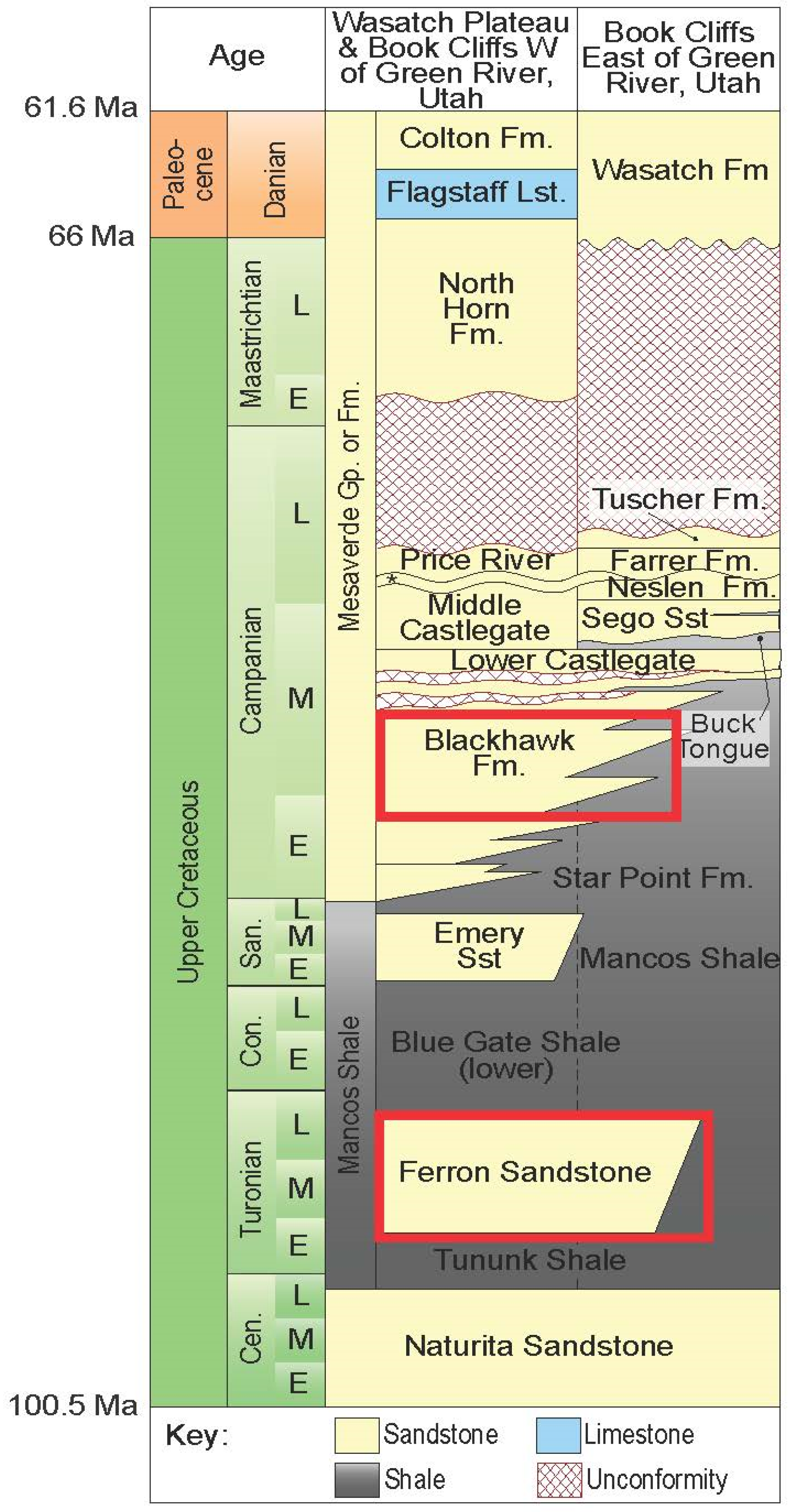

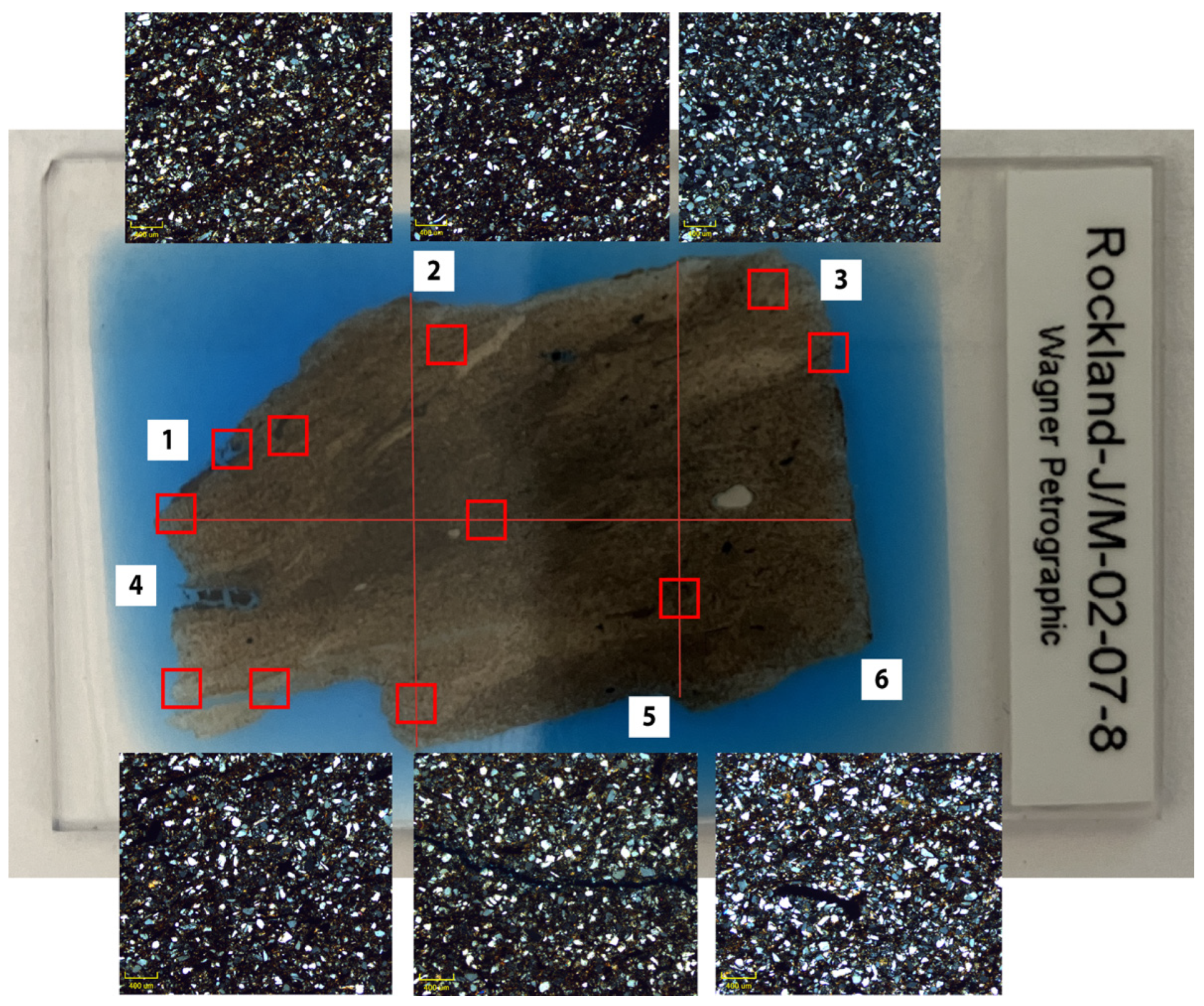

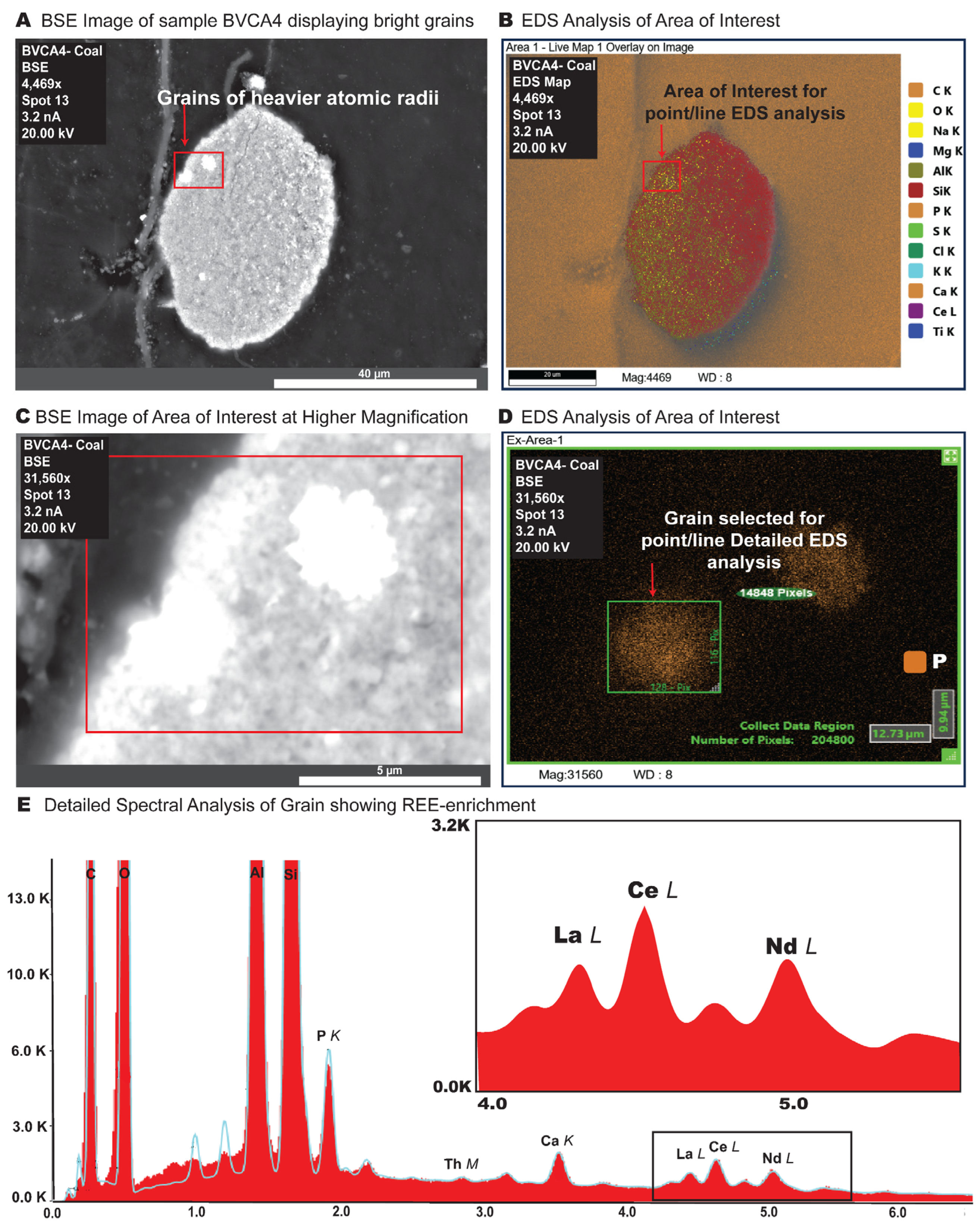
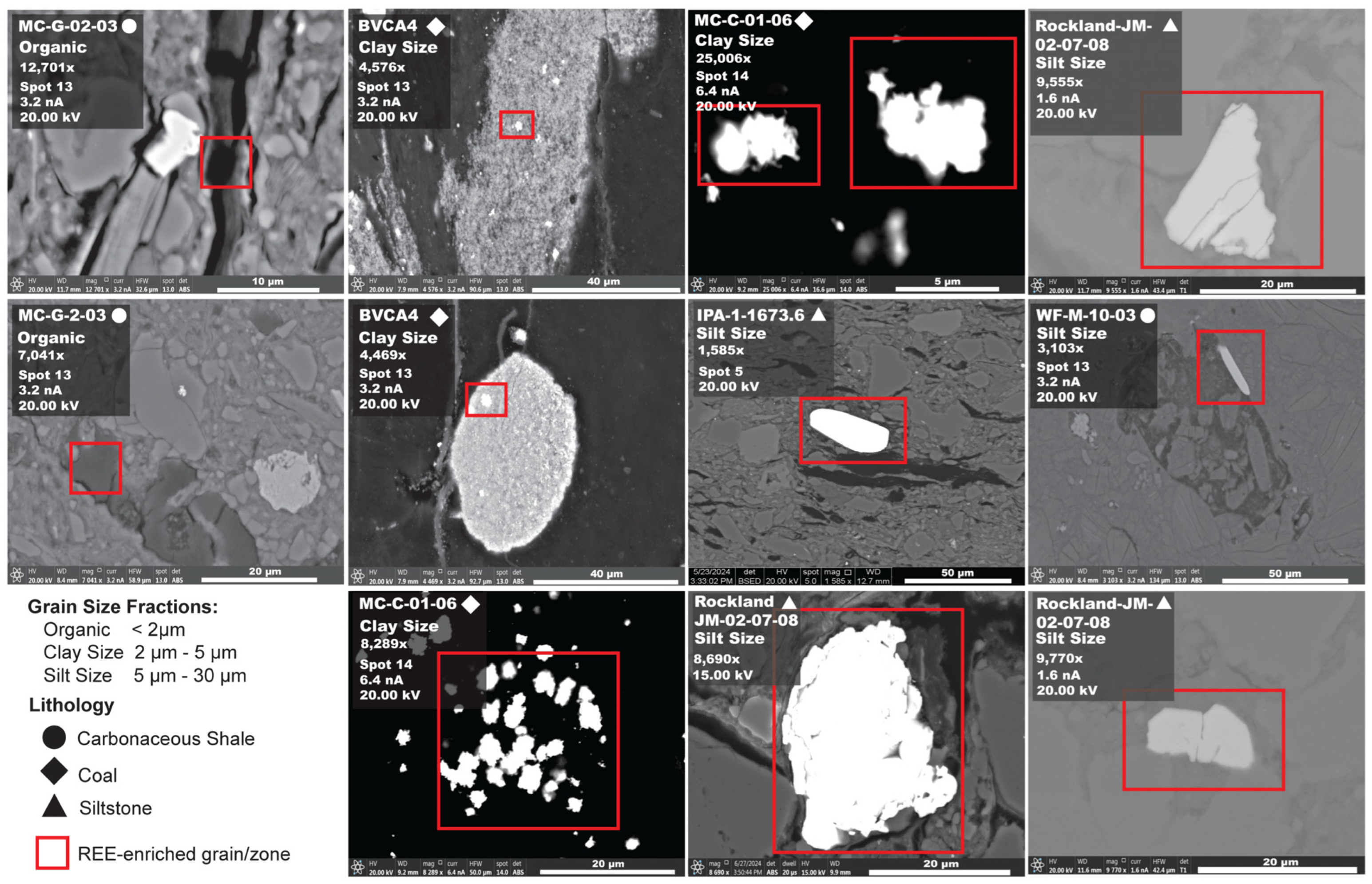

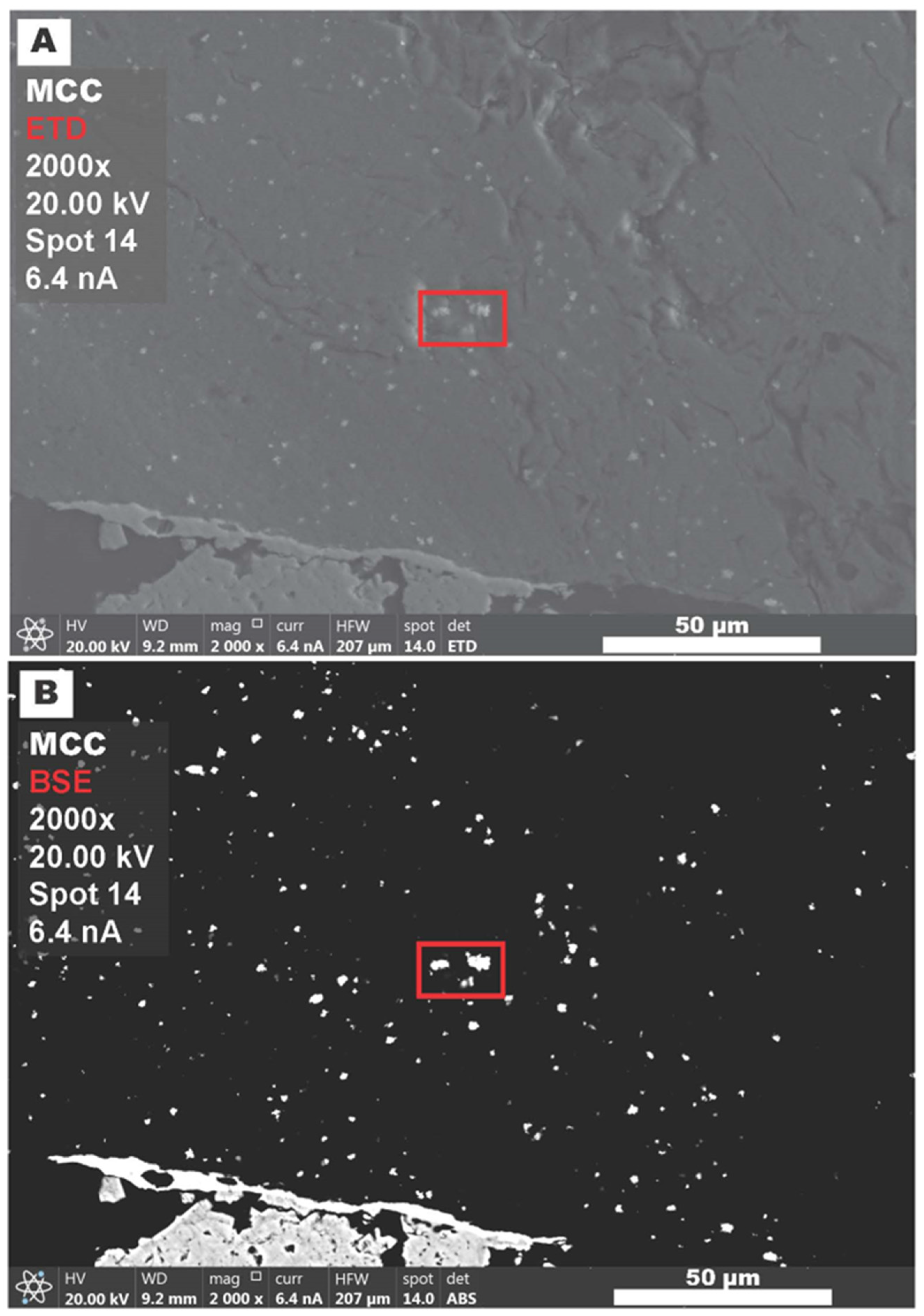

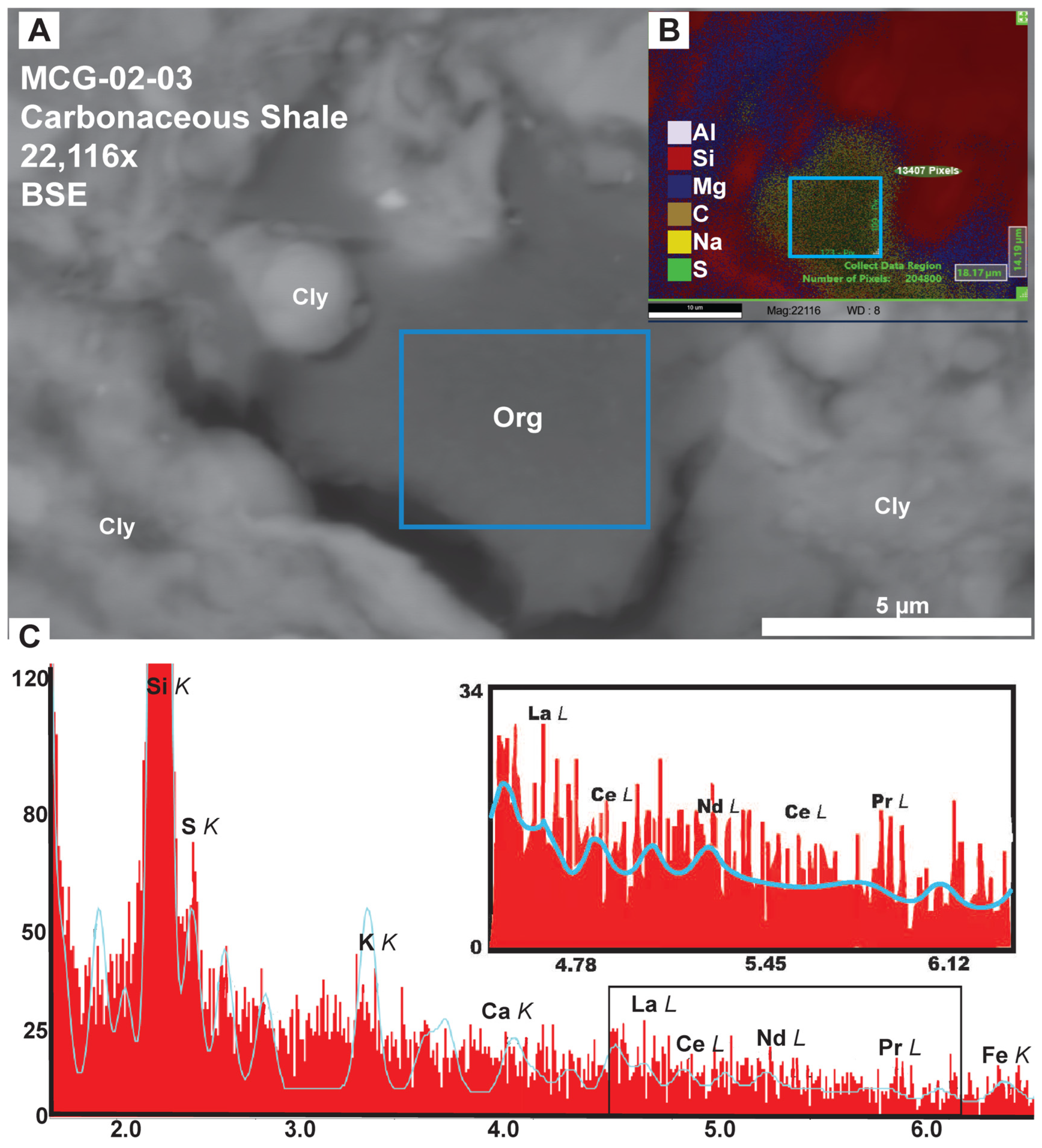
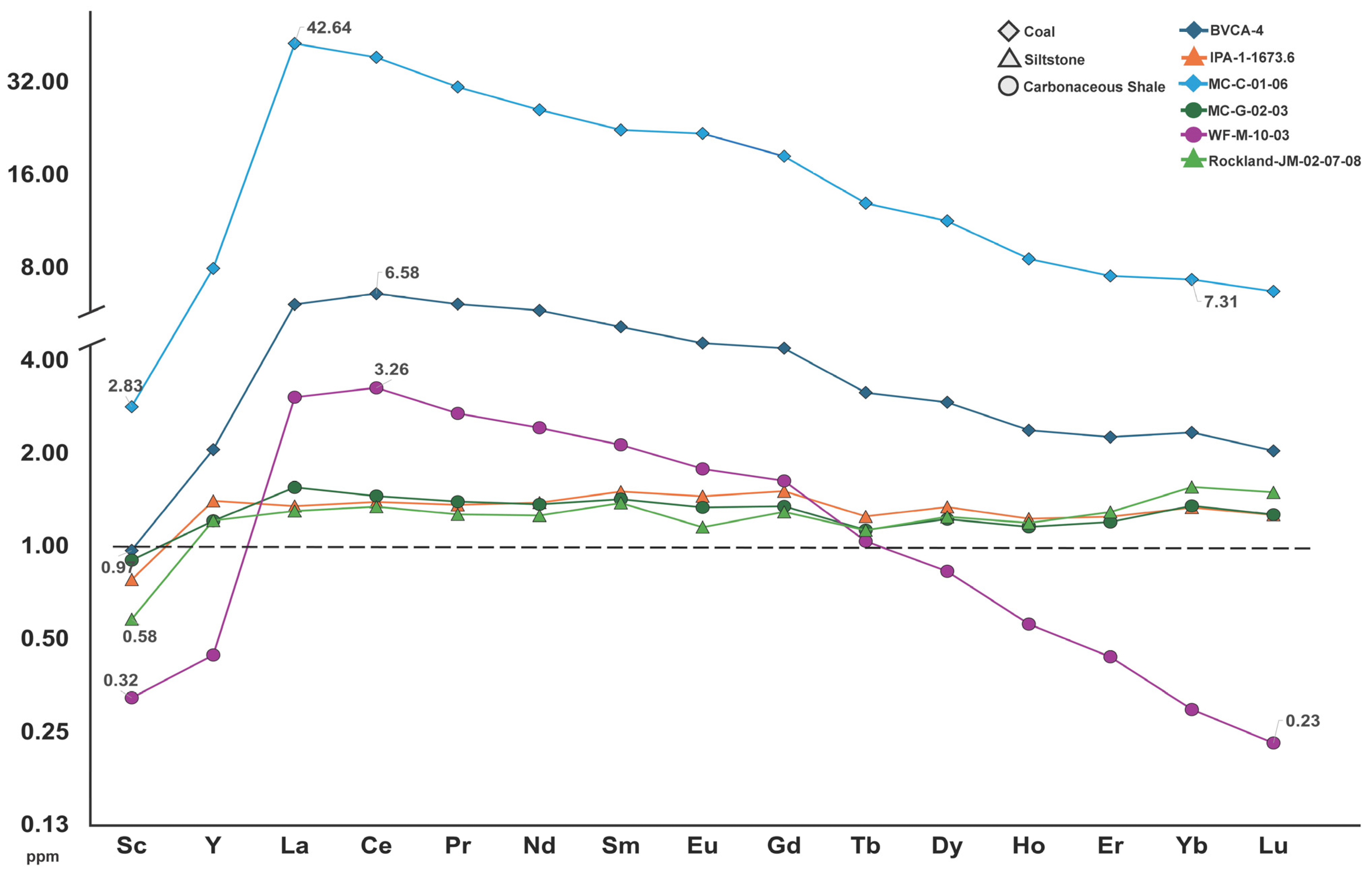
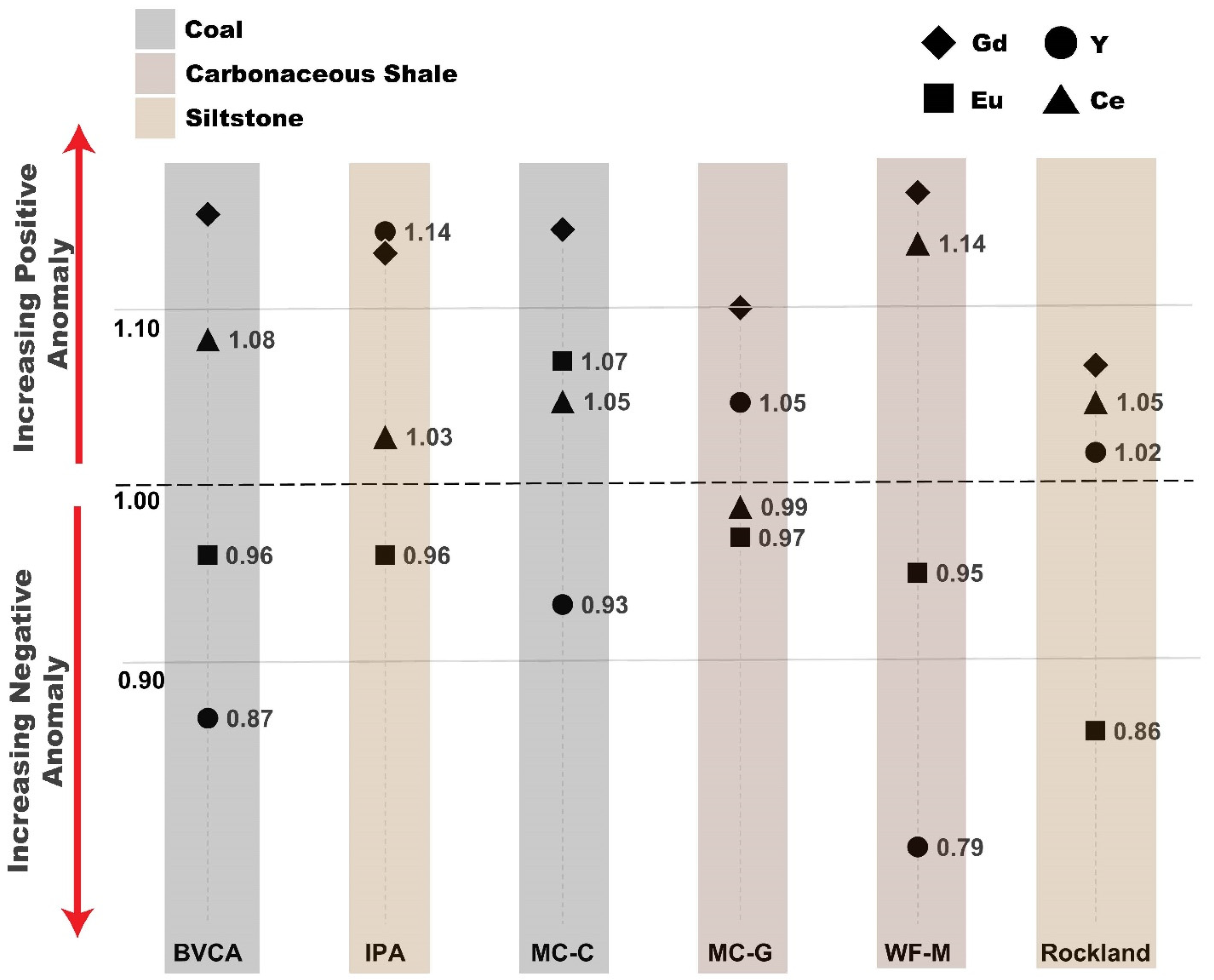

| Sample | Formation | Geologic Age | Simplified Lithology | Coal Field | Location Type | Measured Height (m) | Measured Depth (m) | Named Coal Seam | Adjacency to Coal | Ash % 1 | ICP-MS tREY (ppm) | pXRF REY (ppm) |
|---|---|---|---|---|---|---|---|---|---|---|---|---|
| BVCA-4 | Blackhawk | Campanian | Coal | Wasatch | Mine | - | - | Castlegate A | - | 23 | 934.07 | 473.00 |
| IPA-1-1673.6 | Blackhawk | Campanian | Siltstone | Book Cliffs | Core | - | 510.1 | Sunnyside | Below | - | 244.32 | 3038.33 |
| MC-C-01-06 | Ferron | Turonian | Coal | Emery | Outcrop | 0.1 | - | C | Below | 16 | 5165.65 | 1711.40 |
| MC-G-02-03 | Ferron | Turonian | Carbonaceous Shale | Emery | Outcrop | 0.9 | - | G | Within | 84 | 250.01 | 1852.00 |
| WF-M-10-03 | Ferron | Turonian | Carbonaceous Shale | Emery | Mine | 0.6 | - | M | Above | 87 | 421.70 | 873.90 |
| Rockland-JM-02-07-08 | Ferron | Turonian | Siltstone | Emery | Mine | 2.10 | - | J | Above | 92 | 227.13 | 867.78 |
| Sample | Sc | Y | La | Ce | Pr | Nd | Sm | Eu | Gd | Tb | Dy | Ho | Er | Yb | Lu | ΣREY |
|---|---|---|---|---|---|---|---|---|---|---|---|---|---|---|---|---|
| BVCA-4N | 0.97 | 2.06 | 6.07 | 6.58 | 6.09 | 5.81 | 5.14 | 4.55 | 4.38 | 3.14 | 2.92 | 2.37 | 2.25 | 2.33 | 2.04 | 56.70 |
| BVCA-4A | 13.54 | 43.20 | 188.30 | 414.63 | 43.21 | 156.77 | 24.14 | 4.55 | 17.53 | 2.20 | 11.40 | 1.97 | 5.19 | 4.66 | 0.63 | 931.91 |
| IPA-1-1673.6N | 0.78 | 1.40 | 1.35 | 1.39 | 1.36 | 1.38 | 1.50 | 1.45 | 1.51 | 1.25 | 1.34 | 1.23 | 1.24 | 1.33 | 1.26 | 19.77 |
| IPA-1-1673.6A | 10.89 | 29.44 | 41.79 | 87.62 | 9.66 | 37.36 | 7.06 | 1.45 | 6.02 | 0.87 | 5.22 | 1.02 | 2.86 | 2.67 | 0.39 | 244.32 |
| MC-C-01-06N | 2.83 | 7.95 | 42.64 | 38.46 | 30.81 | 25.97 | 22.33 | 21.76 | 18.35 | 12.93 | 11.33 | 8.53 | 7.51 | 7.31 | 6.70 | 265.41 |
| MC-C-01-06A | 39.57 | 167.01 | 1321.88 | 2422.88 | 218.74 | 701.14 | 104.96 | 21.76 | 73.42 | 9.05 | 44.18 | 7.08 | 17.28 | 14.63 | 2.08 | 5165.65 |
| MC-G-02-03N | 0.90 | 1.21 | 1.55 | 1.45 | 1.39 | 1.37 | 1.42 | 1.33 | 1.35 | 1.13 | 1.22 | 1.15 | 1.20 | 1.35 | 1.26 | 19.28 |
| MC-G-02-03A | 12.59 | 25.33 | 48.04 | 91.55 | 9.90 | 36.87 | 6.67 | 1.33 | 5.38 | 0.79 | 4.76 | 0.96 | 2.75 | 2.70 | 0.39 | 250.01 |
| WF-M-10-03N | 0.32 | 0.44 | 3.04 | 3.26 | 2.69 | 2.42 | 2.13 | 1.78 | 1.63 | 1.04 | 0.83 | 0.56 | 0.44 | 0.30 | 0.23 | 21.08 |
| WF-M-10-03A | 4.51 | 9.30 | 94.11 | 205.08 | 19.10 | 65.24 | 10.00 | 1.78 | 6.51 | 0.72 | 3.23 | 0.46 | 1.00 | 0.59 | 0.07 | 421.70 |
| Rockland-JM-02-07-08N | 0.58 | 1.21 | 1.30 | 1.34 | 1.27 | 1.26 | 1.38 | 1.15 | 1.29 | 1.12 | 1.24 | 1.19 | 1.29 | 1.55 | 1.49 | 18.66 |
| Rockland-JM-02-07-08A | 8.09 | 25.38 | 40.26 | 84.56 | 8.98 | 33.90 | 6.48 | 1.15 | 5.16 | 0.79 | 4.85 | 0.99 | 2.96 | 3.11 | 0.46 | 227.13 |
| Sample | Formation | Lithology | # Grains Processed (EDS) | # REY-Enriched Grains | Size |
|---|---|---|---|---|---|
| BVCA-4 | Blackhawk | Coal | 33 | 5 | 2–5 μm |
| IPA-1-1673.6 | Blackhawk | Siltstone | 20 | 1 | 5–30 μm |
| MC-C-01-06 | Ferron | Coal | 26 | 3 | 2–5 μm |
| MC-G-02-03 | Ferron | Carbonaceous Shale | 21 | 2 | <2 μm |
| WF-M-10-03 | Ferron | Carbonaceous Shale | 17 | 1 | 5–30 μm |
| Rockland-JM-02-07-08 | Ferron | Siltstone | 18 | 3 | 5–30 μm |
| Sample | Formation | Lithology | REY-Bearing Minerals Identified |
|---|---|---|---|
| BVCA-4 | Blackhawk | Coal | La, Ce, and Nd clusters of phosphate clay-size grains (≤5 µm) found in zones of the clay matrix (<1 µm) |
| IPA-1-1673.6 | Blackhawk | Siltstone | Ce-bearing monazite grain > 10 µm |
| MC-C-01-06 | Ferron | Coal | La, Ce, Pr, and Nd clusters of monazite clay-size grains (≤5 µm) throughout zones of the clay matrix (<1 µm) |
| MC-G-02-03 | Ferron | Carbonaceous Shale | La, Ce, Pr, and Nd unevenly dispersed throughout two small (<1 µm) zones of the organic matrix |
| WF-M-10-03 | Ferron | Carbonaceous Shale | La, Ce, and Nd-bearing monazite grain > 10 µm; primary signal is Ce |
| Rockland-JM-02-07-08 | Ferron | Siltstone | La, Ce, Pr, and Nd in two monazite grains > 10 µm; primary signal is Ce Y-enriched xenotime was also identified in a >10 µm grain |
| Sample | Lithology | LREE | HREE | Ratio |
|---|---|---|---|---|
| BVCA-4 | Coal | 831.60 | 43.57 | 19.08 |
| IPA-1-1673.6 | Siltstone | 184.94 | 19.05 | 9.70 |
| MC-C-01-06 | Coal | 4791.36 | 167.71 | 28.56 |
| MC-G-02-03 | Carbonaceous Shale | 194.36 | 17.73 | 10.95 |
| WF-M-10-03 | Carbonaceous Shale | 395.30 | 12.59 | 31.38 |
| Rockland-JM-02-07-08 | Siltstone | 175.34 | 18.32 | 9.57 |
Disclaimer/Publisher’s Note: The statements, opinions and data contained in all publications are solely those of the individual author(s) and contributor(s) and not of MDPI and/or the editor(s). MDPI and/or the editor(s) disclaim responsibility for any injury to people or property resulting from any ideas, methods, instructions or products referred to in the content. |
© 2025 by the authors. Licensee MDPI, Basel, Switzerland. This article is an open access article distributed under the terms and conditions of the Creative Commons Attribution (CC BY) license (https://creativecommons.org/licenses/by/4.0/).
Share and Cite
Wilcock, L.; Birgenheier, L.P.; Morris, E.A.; Fausett, P.D.; Coe, H.H.; Fernandez, D.P.; Gall, R.D.; Vanden Berg, M.D. REY Spatial Distribution and Mineral Association in Coal, Carbonaceous Shale and Siltstone: Implications for REE Enrichment Mechanisms. Minerals 2025, 15, 869. https://doi.org/10.3390/min15080869
Wilcock L, Birgenheier LP, Morris EA, Fausett PD, Coe HH, Fernandez DP, Gall RD, Vanden Berg MD. REY Spatial Distribution and Mineral Association in Coal, Carbonaceous Shale and Siltstone: Implications for REE Enrichment Mechanisms. Minerals. 2025; 15(8):869. https://doi.org/10.3390/min15080869
Chicago/Turabian StyleWilcock, Laura, Lauren P. Birgenheier, Emma A. Morris, Peyton D. Fausett, Haley H. Coe, Diego P. Fernandez, Ryan D. Gall, and Michael D. Vanden Berg. 2025. "REY Spatial Distribution and Mineral Association in Coal, Carbonaceous Shale and Siltstone: Implications for REE Enrichment Mechanisms" Minerals 15, no. 8: 869. https://doi.org/10.3390/min15080869
APA StyleWilcock, L., Birgenheier, L. P., Morris, E. A., Fausett, P. D., Coe, H. H., Fernandez, D. P., Gall, R. D., & Vanden Berg, M. D. (2025). REY Spatial Distribution and Mineral Association in Coal, Carbonaceous Shale and Siltstone: Implications for REE Enrichment Mechanisms. Minerals, 15(8), 869. https://doi.org/10.3390/min15080869







